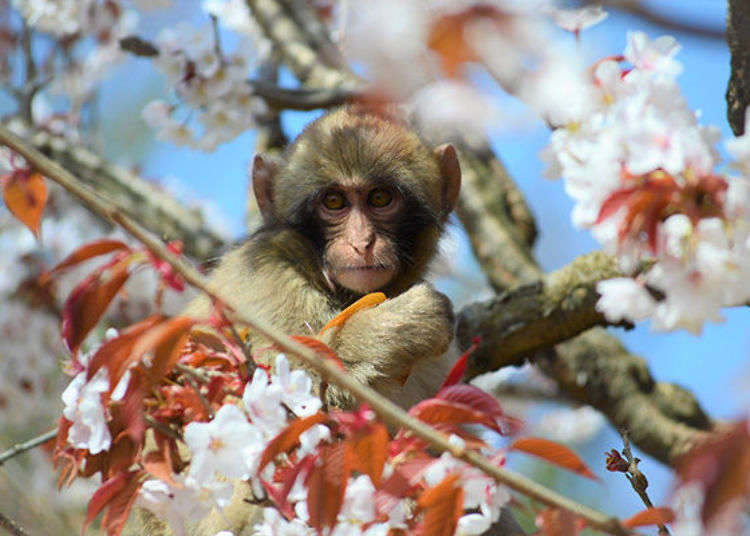
Arashiyama Monkey Park Iwatayama is a popular Kyoto destination where you can see wild Japanese macaques up close. We visited the park in spring during the child rearing season, when you can see many cute baby monkeys!
Meeting Wild Monkeys on the Mountain!
Arashiyama Monkey Park Iwatayama is located at peak of Mt. Iwata, with a height of 160m. Around the rest area at the peak you are able to meet wild monkeys.
Currently there are about 120 Japanese macaques living here. This location is known for being able to see wild monkeys up close and being able to feed them safely. In recent years there has been an increase of foreign visitors.

The path to the peak is on the south side of Togetsu-kobashi Bridge, and along the river where Rankyo Meguri dock is located. Pictured is the view from Togetsu-kobashi. Arashiyama is to the left, the round mountain to the front is Mt. Ogura (which is listed on the famous Japanese card game Haykunin Issu), behind which is Mt. Atagoya.
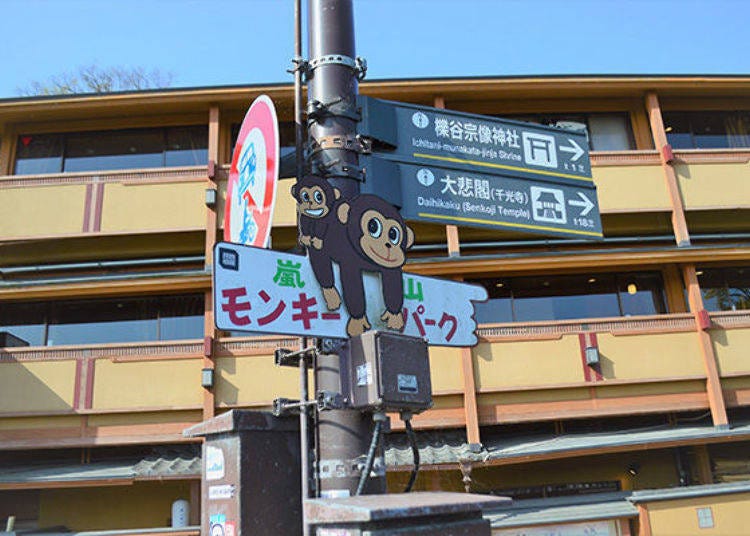


The view of Togetsu-bashi Bridge near the entrance. A beautiful view of cherry blossoms in full bloom when we visited on March 30, 2018.
Next to the shrine is the reception and the gate to the peak. After paying the entrance fee and getting a pamphlet, it takes about 20 minutes to get to the rest area at the peak.
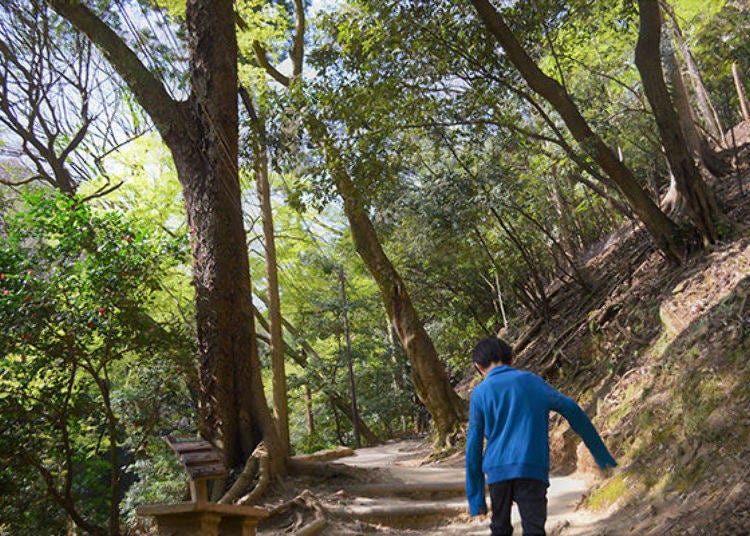
After climbing the 120 steps from the entrance, the rest of the way is a gentle ascent. The path up is not steep and shouldn’t be an issue for young children. Another great feature of the path is the view it provides throughout the season: cherry blossoms during spring, vibrant greens during the summer, and colored leaves in autumn. Enjoy the refreshing air on your way up.

Once you see this sign, you are almost there. This area has a field and playground for children such as a long slide and a swing rope. To go down the mountain you will take a different path, so it might be better to have some fun here before meeting the monkeys.
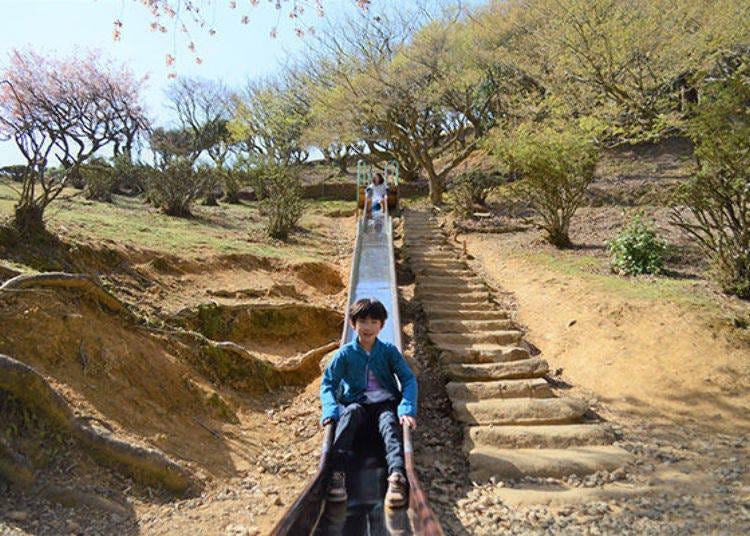

The rest area at the peak. This area has a manager’s office, toilet, small shop and an indoor feeding area. The monkeys live freely around the pond, fields and trees.
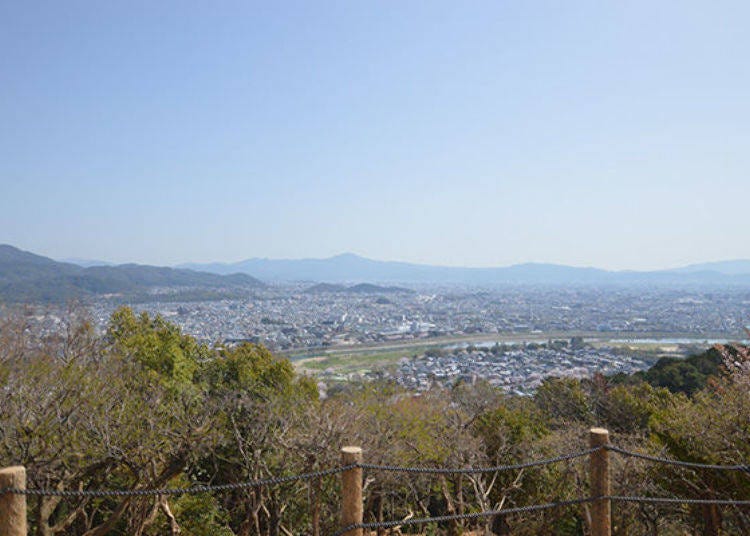
The peak provides a panoramic view of Kyoto! Quite envious of these monkeys that get to live in such a nice place.
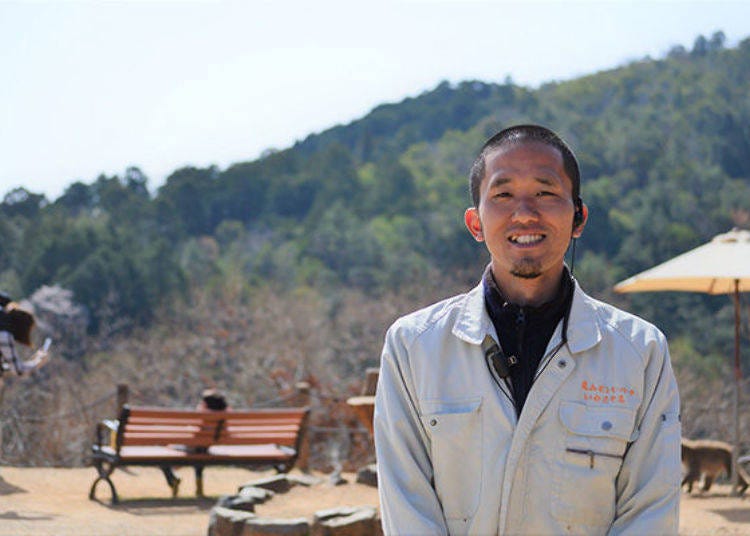
We interviewed Mr. Tamata who is the handler here. Normally he feeds the monkeys and give explanations about monkeys to tourists.
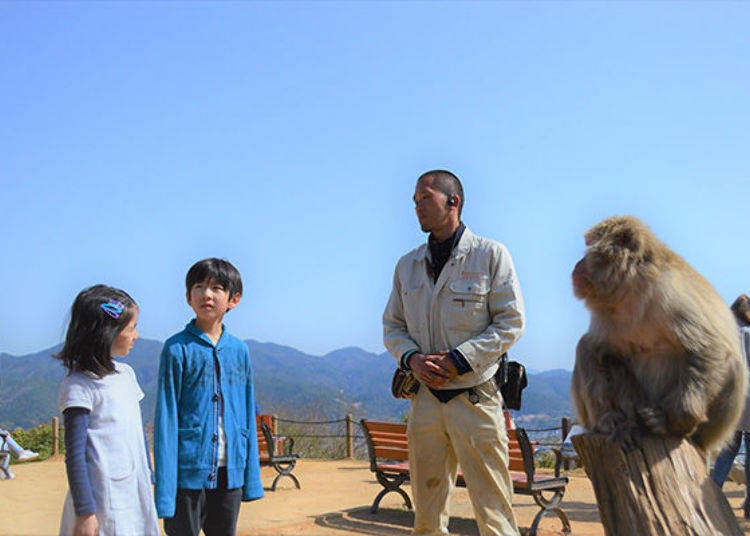
A quick quiz from Mr. Tomita,“What do you think this monkey’s name is?” Not, sure maybe the standard Monkichi or Mon-chan?
“Nope. This monkeys name is Mino. Well his official name is Mino 63-75-92.” The children listening are surprised by the long name with numbers!
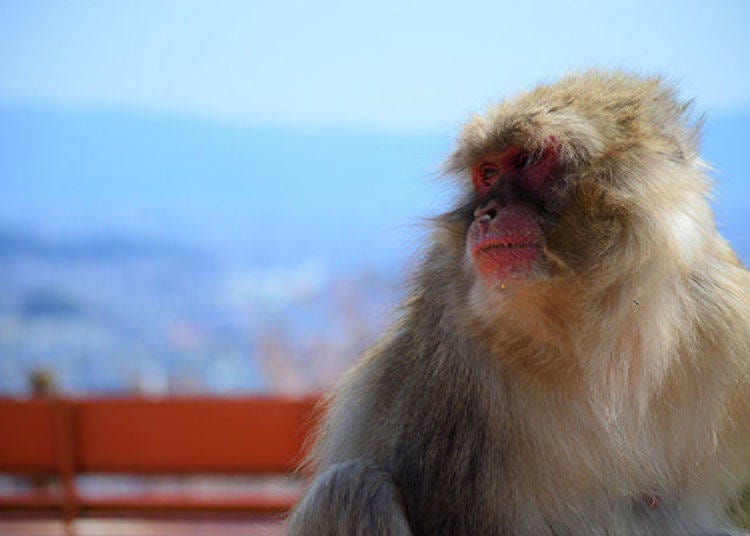
There is a rule to naming the monkeys at Iwatayama. The first generation monkeys were named in 1957 (Showa 32) when the park was opened, after that the last two digit of the year is added to the name. The child of Mino born in 1963 had a child in 1975 and it had a child in 1992, so Mino 63-75-92 is a great-grandchild.
Mino 63-69-74-83-92 in the picture is the great-great-grandchild. This monkey has inherited the name through five generations! The average life span of a monkey is about 30 years, a bit less than half that of a human’s.

Now a quiz from the writer! What is the mood of the monkey in the picture? Is it afraid? Happy? How does it look?
The answer is...Angry! When they open their mouth hiding their upper teeth is a sign of intimidation. If you look at them in the eyes from the front or get to close, they will make this facial expression. So it is better to be at least 2 meters away from the monkeys when you look at them.

Question #2! Is the monkey in the picture a male or female? Quite an easy question.
The answer is... Female! There are two hints that give it away, the first being the long nipples show that this female has experience in child rearing. The other is the bum: on males you can see their testicles and females have a tight crotch area.
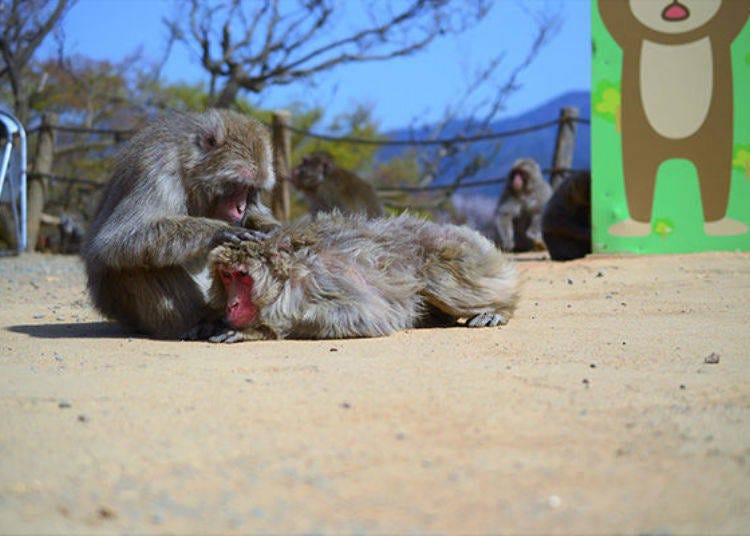
Final question! What are these monkeys doing? Another easy question.
The answer is grooming. The monkeys in the picture are a family and the mother is grooming her child. This is a method of communication that is conducted between males and females, and families. At the park you can see many monkeys grooming each other.
Instead of just looking at the monkeys, it is more engaging learning about monkey facts. If you are interested or have a question, you can always ask the handlers at the park.
Hand-Feed the Monkeys at the Arashiyama Monkey Park Rest Area!

And now it’s on to the exciting up-close monkey feeding time! Here you can hand-feed the monkeys food sold at the store (1 bag 100 yen) by hand through the fence.

If you take the snack towards the fence, monkeys start to gather. These are wild monkeys, but why do they live in the area of this mountain?
The answer is, because there is always food. Monkeys have a habit of living where there is food, and if the food runs out they move. This rest area has a constant source, from visitors feeding them and handlers giving out food. The monkeys know this and live here.
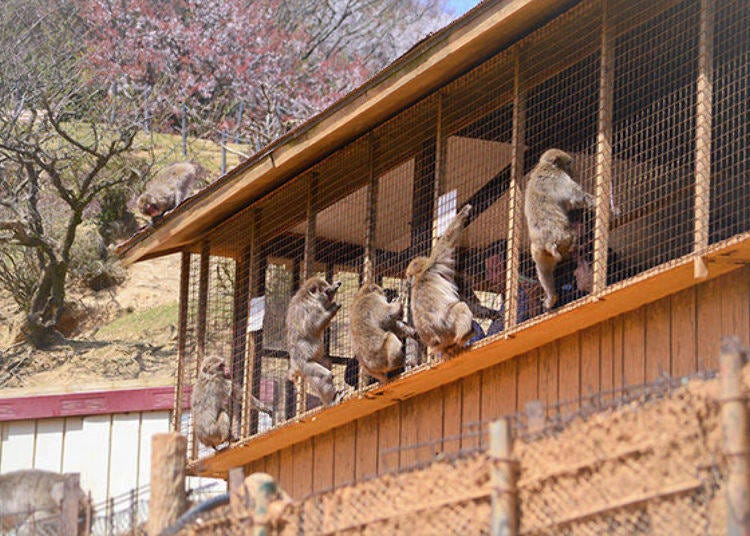

In the rest area the handlers are preparing the food. This day they prepared bananas, peanuts, and apples. The most popular one is bananas.
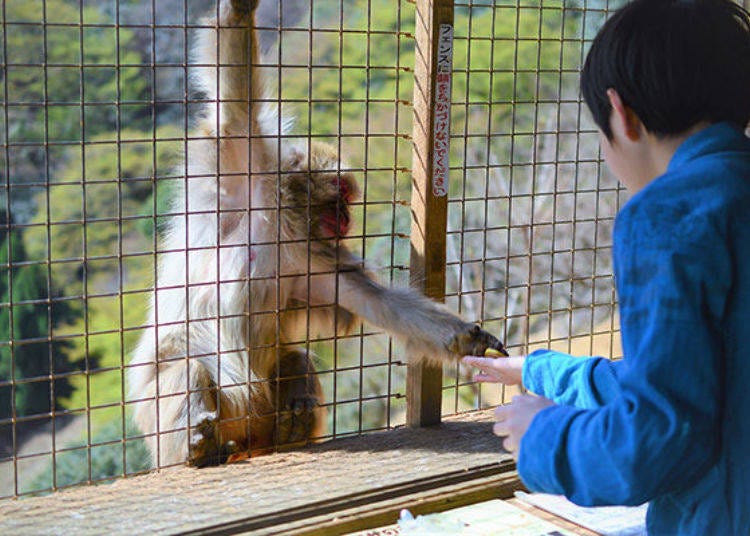
Place the food on your hand and the monkeys will take it. They are pretty quick and can be startling at first, but it gives you a chance to check out their little hands and fingers up close.
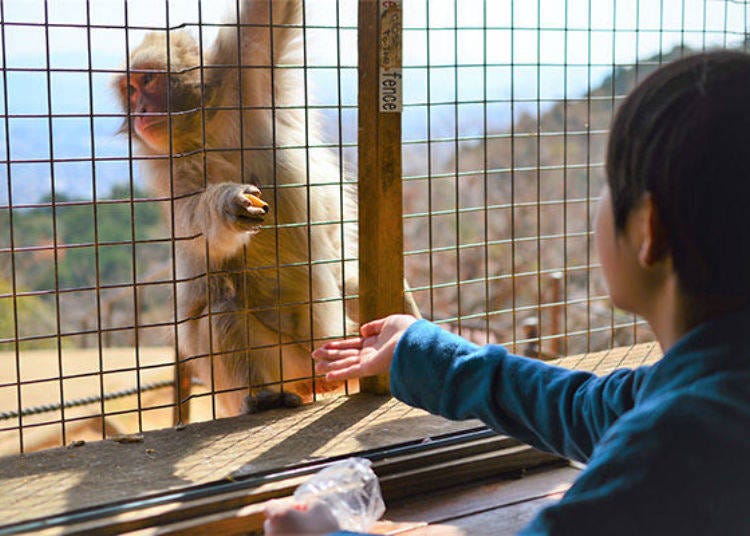

They cleverly peel the banana with their hand and mouth and eat it. If you are this close, you can get a good look of their facial expression!
This is a pretty rare experience, being able to see a monkey up close—even if it is through a fence. According to Mr. Tamata, it is popular with foreign visitors due to how close you can get. Also you are not allowed to bring your own food to feed them or feed them out of the feeding area. Make sure to buy the food from the store and feed them from the
Spring to Summer is the Child Rearing Season! You Might be able to See a Cute Baby Monkey
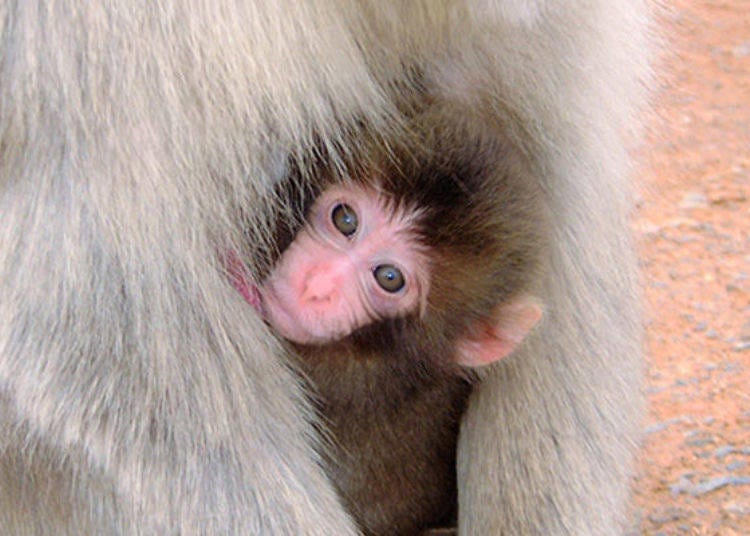
Every year from April to July is the childbirth season. During this time you might be able to see baby monkeys hanging on their mother’s stomach. The monkey in the picture is a baby. Their coat is darker than that of their mother’s and they have cute round eyes!

When we visited we weren’t able to see any babies, however there were many young monkeys that were born last year running around! It was very cute seeing monkey siblings running around their mother and eating food.
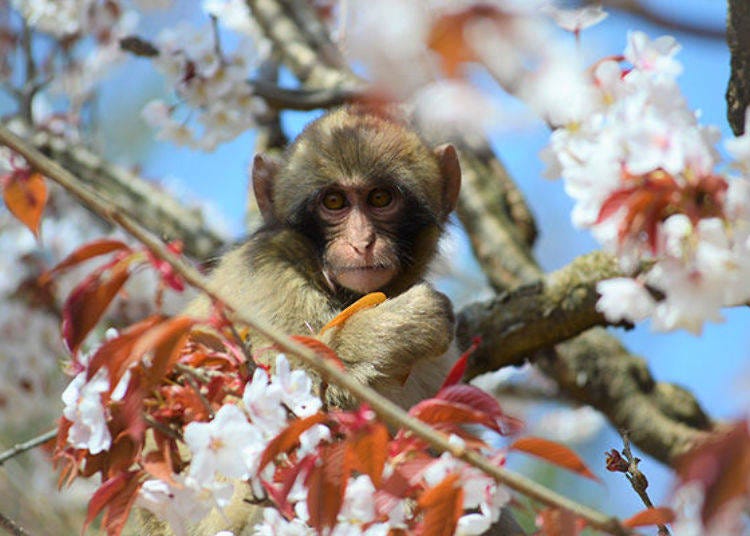
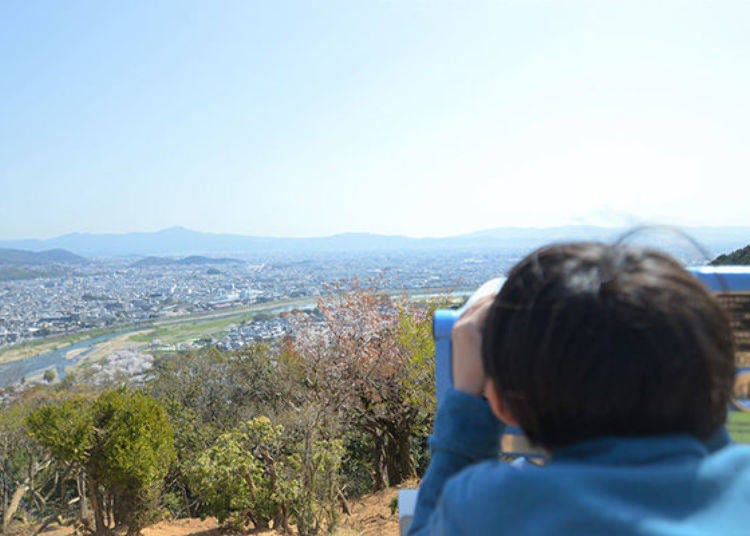
Arashiyama Monkey Park offers the rare chance to see wild monkeys up close. You can interact with monkeys and also get a great view of Kyoto City. Also on a clear day you can even see Kyoto Tower.
-

-
Address
61, Arashiyamanakaoshitacho, Nishikyo-ku, Kyoto-shi, Kyoto, 616-0004
View Map -
Nearest Station
Arashiyama Station (Keifuku Dentetsu-arashiyama Line)
6 minutes on foot
- Phone Number 075-872-0950
-
Address
61, Arashiyamanakaoshitacho, Nishikyo-ku, Kyoto-shi, Kyoto, 616-0004
- Area
- Category
*Prices and options mentioned are subject to change.
*Unless stated otherwise, all prices include tax.
Popular Tours & Activitiess
Recommended places for you
-

ISHIDAYA Hanare
Yakiniku
Kobe, Sannomiya, Kitano
-

Kanzenkoshitsuyakinikutabehodai Gyugyu Paradise Sannomiya
Yakiniku
Kobe, Sannomiya, Kitano
-

Kambei Sannomiyahonten
Yakiniku
Kobe, Sannomiya, Kitano
-

Jukuseiniku-to Namamottsuarera Nikubaru Italian Nikutaria Sannomiya
Izakaya
Kobe, Sannomiya, Kitano
-
Goods

Yoshida Gennojo-Roho Kyoto Buddhist Altars
Gift Shops
Nijo Castle, Kyoto Imperial Palace
-

TOEI KYOTO STUDIO PARK
Theme Parks
Arashiyama, Uzumasa
-
Ad

Experiencing Manga as Culture, Not Just Reading It: Expo 2025 with Rumiko Takahashi
-

History and Sustainable Brewing: World-Renowned Fukuju Sake at Kobe Shushinkan
by: WESTPLAN
-
Ad

Visiting the Osaka–Kansai Expo? Enjoy These 5 Great Itineraries from Osaka-umeda for Nature and City Lovers
-

Best Things to Do and See Around Kyoto & Osaka in September: Events and Festivals in Kansai
-

November Events in Kansai: Fun Festivals, Food, and Things to Do in Kyoto & Osaka
-

Curious About Sake? I Visited a Sake Brewery in Japan and Here's What I Learned
Inspiration for Accommodations
-

Spacious Family Hotel in Namba: 20 Comfortable Stays for Family Fun
-

Charming Hotels to Enjoy the Spectacular Views of Arashiyama's Autumn Leaves from Your Room
-

Experience Stunning Views of Osaka Castle from Private Spaces: Top Hotels Near Osaka Castle
-

Recommended by Visitors! Arashiyama's Best-Rated Hotels
-

Family-Friendly Universal Studios Japan Hotel with Excellent Access
-

Enjoy a Comfortable Stay in Osaka! 10 Hotels with Convenient Airport Shuttle Services
-

Top 10 Recommended Hotels Near Namba Station with Great Access
-

Enjoy Night Views from Your Room! Recommended Hotels in Namba Area
-

Kiyomizu-dera Temple: Guide to Visiting Kyoto's Most Famous Sightseeing Spot
-

Legoland Discovery Center in Osaka Guide: Enjoy the World of Lego at a Fun Indoor Facility
by: WESTPLAN
-

Staying Safe While Having Fun! Universal Studios Japan Combats the Coronavirus Pandemic!
-

Popular Food at Universal Studios Japan
by: WESTPLAN
-

Minions Galore! Universal Studios Japan’s Top Christmas Goods and Food Review (2019)
by: WESTPLAN
-

Sightseeing Highlights: Experience the Appeal of Kyoto Geisha Culture
- #best gourmet Osaka
- #things to do Osaka
- #what to do in kyoto
- #what to bring to japan
- #best gourmet Kyoto
- #new years in Osaka
- #what to buy in nanba
- #Visiting Osaka
- #onsen tattoo friendly arima
- #daiso
- #Visiting Kyoto
- #best japanese soft drinks
- #japanese fashion culture
- #japanese convenience store snacks
- #japanese nail trends













